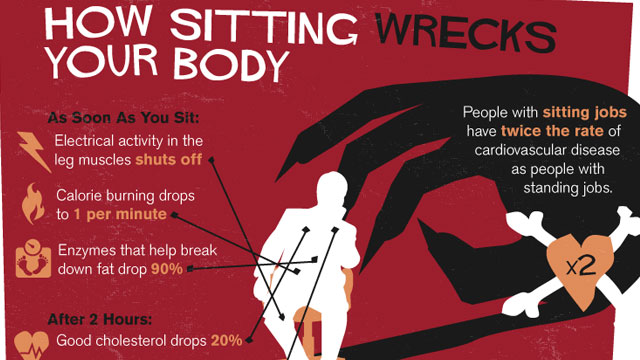 If there’s one thing that nearly all people have in common these days, it’s that we spend a lot of time sitting. While our great shift towards computer-based work and entertainment has improved our productivity and enjoyment, it means that we now spend more time being sedentary. Sedentary behaviour can include activities such as lying down, reading, watching television, using the computer and other forms of screen-based entertainment. Research has shown that the average person can spend more than half of their waking hours engaged in these sedentary activities! (See reference 1)
If there’s one thing that nearly all people have in common these days, it’s that we spend a lot of time sitting. While our great shift towards computer-based work and entertainment has improved our productivity and enjoyment, it means that we now spend more time being sedentary. Sedentary behaviour can include activities such as lying down, reading, watching television, using the computer and other forms of screen-based entertainment. Research has shown that the average person can spend more than half of their waking hours engaged in these sedentary activities! (See reference 1)
Recently, there has been a growing interest in studying the relationship between our sedentary behaviour and our health. Of particular interest has been the relationship between increased time spent ‘sitting’ and the rise in chronic diseases such as cardiovascular disease, diabetes and cancer. Approximately 50% of people in North America have one or more of these chronic diseases and this number is steadily on the rise (See reference 2). While the increasing prevalence of these chronic diseases is due to a number of different factors, those things that are easiest to fix (such as a sedentary lifestyle), are of particular interest to doctors.
Several scientific reviews have examined the potential health risks associated with too much time being sedentary, and recent studies have suggested that this might be a bigger problem than previously expected. Below, I have summarized a few of the reviews that have examined the issue:
Diabetes?
A recent review (and meta-analysis) combined the results of all of the published research studies that tested for a link between sedentary behaviour and metabolic syndrome (See reference 3). Metabolic syndrome is a combination of medical disorders that are associated with cardiovascular disease and diabetes, such as central obesity, raised triglycerides and increased fasting plasma glucose.
10 studies (all prospective and cross-sectional) were identified in this review. Most of those studies assessed self-reported screen viewing time, while only one study assessed ‘total sitting time’. After combining the results, the authors found that greater time spent sitting in front of a TV screen increased the odds of metabolic syndrome by up to 73%. This association was not influenced by sex of the participants, the sedentary measure or metabolic syndrome definition employed, or by study quality.
Heart Disease?
A systematic review published this year examined all the available research that examined the link between sedentary behaviour and heart disease (See reference 4). The authors found four studies that looked at ‘total sitting time’ and risk of heart disease – all of them found that increased ‘sitting time’ was associated with a higher risk of cardiovascular disease. In addition, all found that the negative health effects of prolonged sitting were more pronounced among women.
Furthermore, six studies specifically incorporated questions about the amount of time spent watching television. Similar to those studies examining total sitting time, these six studies showed that as time spent each day watching television increased, so did the risk of cardiovascular disease.
Cancer?
Another literature review published this year examined all of the research that tested for a link between sedentary behaviour and cancer (See reference 5). The authors were able to find 18 relevant research studies and 11 of those studies specifically examined if increased ‘sitting time’ was associated with increased risk of developing cancer. Most of the 11 studies assessed ‘total sitting time’, while some only looked at time spent watching television.
In 10 of the 11 studies, it was found that increased time spent sitting was associated with an increased risk of developing cancer; 8 of these 10 were statistically significant associations. The greatest risk increases were found for colorectal cancer, followed by ovarian, prostate, and endometrial cancer.
Death?
A recent study in Australia compared activity levels for over 200,000 people, aged 45 years or older, to the Australian registry of deaths (See reference 6). There was an association found between time spent sitting and all-cause mortality; this was consistent across the sexes, age groups, body mass index categories, and physical activity levels. The authors of this study concluded that prolonged ‘sitting time’ is a risk factor for death from any cause.
Conclusions:
So what’s the take-home message? These studies of sedentary behaviour and adverse health have shown that prolonged sitting is associated with increased risk of diabetes, heart disease, certain cancers and even death. In fact, a 2011 review in the Journal of the American Medical Association concluded that “Prolonged TV viewing was associated with increased risk of type 2 diabetes, cardiovascular disease, and all-cause mortality” (See reference 7).
Moreover, these associations are usually shown to be at least partially independent of levels of physical activity. This means that even if you exercise every day, the more time you spend sitting, the higher your risk of disease or death. Thus, it seems that encouraging people to limit their time spent sitting may be just as important as encouraging people to spend more time exercising, as both are important for optimal health.
What can you do to reduce your time spent sitting? The key may be in finding any excuse possible to stand and/or walk somewhere, as many times as possible throughout the day. Although this can be particularly difficult because of modern changes in personal transportation, communication, workplace environments, and domestic entertainment technologies that have significantly reduced our daily physical demands, finding ways to incorporate more activity into your daily routine is not impossible. Ultimately, it boils down to making a conscious decision to rely less on some of our modern technologies, in order to prevent them from being the ‘death of us’.
Some examples of how to reduce ‘sitting time’:
– Do your food preparation or ironing (or other chores) while you watch t.v.
– Do some ‘core’ exercises on a stability ball while you watch t.v.
– Go for a short walk after lunch at work (especially if your job involves ‘sitting’)
References:
1) Matthews CE, Chen KY, Freedson PS, Buchowski MS, et al. Amount of time spent in sedentary behaviors in the United States, 2003-2004. Am J Epidemiol. 2008 Apr 1;167(7):875-81.
2) Anderson G, Horvath J. The growing burden of chronic disease in America. Public Health Rep. 2004;119:263-70.
3) Edwardson CL, Gorely T, Davies MJ, Gray LJ, Khunti K, et al. Association of sedentary behaviour with metabolic syndrome: a meta-analysis. PLoS One. 2012;7(4):e34916.
4) Ford ES, Caspersen CJ. Sedentary behaviour and cardiovascular disease: a review of prospective studies. Int J Epidemiol. 2012 May 26.
5) Lynch BM. Sedentary behavior and cancer: a systematic review of the literature and proposed biological mechanisms. Cancer Epidemiol Biomarkers Prev. 2010 Nov;19(11):2691-709.
6) van der Ploeg HP, Chey T, Korda RJ, Banks E, Bauman A. Sitting time and all-cause mortality risk in 222 497 Australian adults. Arch Intern Med. 2012 Mar 26;172(6):494-500.
7) Grøntved A, Hu FB. Television viewing and risk of type 2 diabetes, cardiovascular disease, and all-cause mortality: a meta-analysis. JAMA. 2011 Jun 15;305(23):2448-55.

